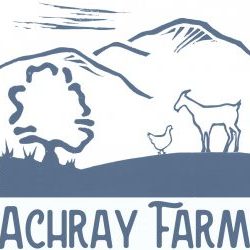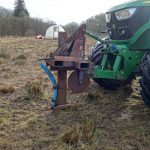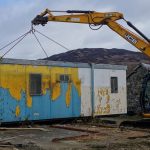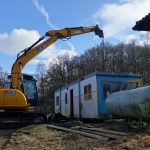It’s been a long time since we wrote a blog, but that doesn’t mean things have been quiet at Achray Farm. In 2021 we have kidded 14 healthy goats (lots of triplets), almost completed The Bothy (awaiting Building Control), grown (in people and fruit and veg), completed a life goal (HT 550) and re-opened the ice cream with the newly converted rice trailer. There are images of all these on our Instagram page that is updated often.
What we have noticed with all the ice cream customers who have come through come rain or shine is a common set of questions, so just for fun for those who can’t ask us in person here are some of the answers…
What are those birds?
They are Guinea Fowl. We have six here and they were hatched from eggs in an incubator during lockdown 2020. They are here to eat tics to keep the numbers down in the fields for us and the goats, and they are also alarm birds (that “cry wolf” a bit too often). We eat their eggs – just smaller than a hen egg, fabulous with a 3-minute boil on fresh sourdough toast.
Are your ice-creams allergen free?
We have no nuts in the kitchen and all our ingredients are gluten- and cow-dairy free. We make vegan sorbets (for everyone) and can serve ice cream in bamboo-boats for those avoiding wheat or soya in our waffle cones (or who just prefer a tub and recyclable-spoon).
How many goats do you have?
17 at present (August 2021). 7x milkers (plus two “on loan” for the summer season). 1x matriarch. 2x boys, the billys to this year’s kids. 5x kids – four girls and one boy.
They are called Ria, Rosie, Rhianna, Kaitlyn, Missie, Chloe, Shadow, (Bambi & Hester). Pan. Mr Micawber and Sproggit. Tilly, Tallulah, Celeste, Trixie. And Trig.
Do you live here? / How long have you been here?
We moved to Achray Farm about 5 years ago in autumn 2016, having both been in Scotland for 25+years each. Crispin from down the road in Doune and Nicola over from Fife. This is our home. The ice cream launched in August 2020 after 3 years of herd building, planning and building and compliance testing with the authorities for production and sales.
What’s it like in winter?
Quiet. For visitors driving on the Three Lochs Forest Drive, having not seen another property for 6 miles of gravel road, it looks like we are in the middle of nowhere. However, our private vehicle access is only 400m to the main road at Brig o’ Turk. There is snow, sometimes, but not as much as on the hills. Winter is a time to regenerate and take it easier than the 7am to 11:30pm work-with-the-daylight hours of midsummer.
What’s under the cover?
It’s an Alfa Romeo Spider, just over 30 years old (not the really pretty boat-tail original style from The Graduate). It’s been owned about 20 years and has been to Italy and back. The number plate came waaaaaay before the farm or any inklings that direction.
It goes but it doesn’t stop at the moment!
What other animals do you have?
We have a couple of ducks that live in the back field and a small flock of hens that wander wherever they can that supply eggs to the village. We have two cats and the guinea fowl.








